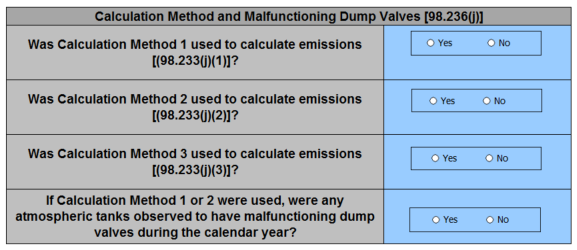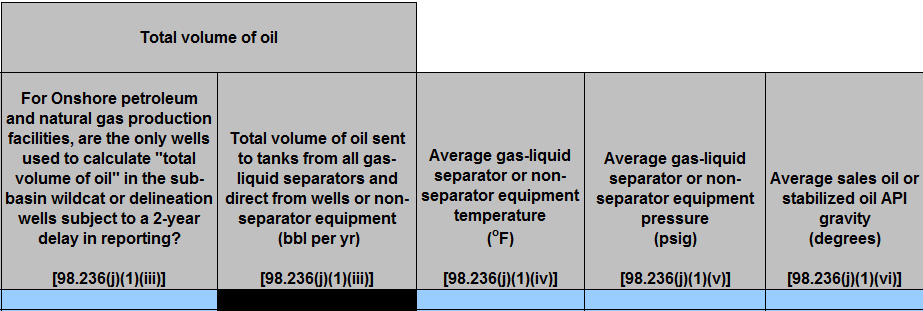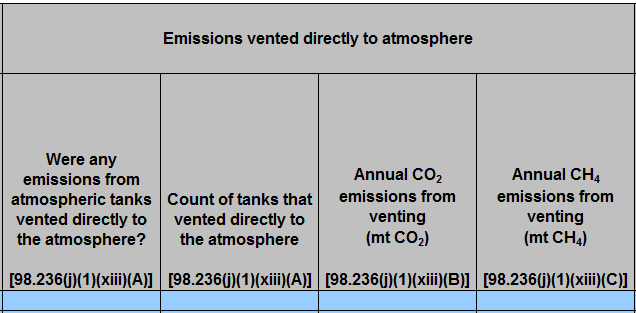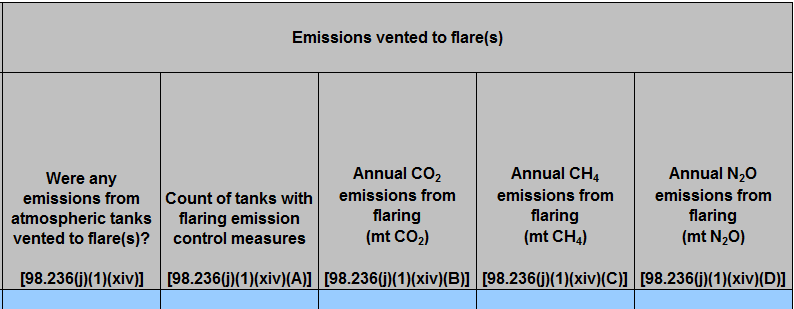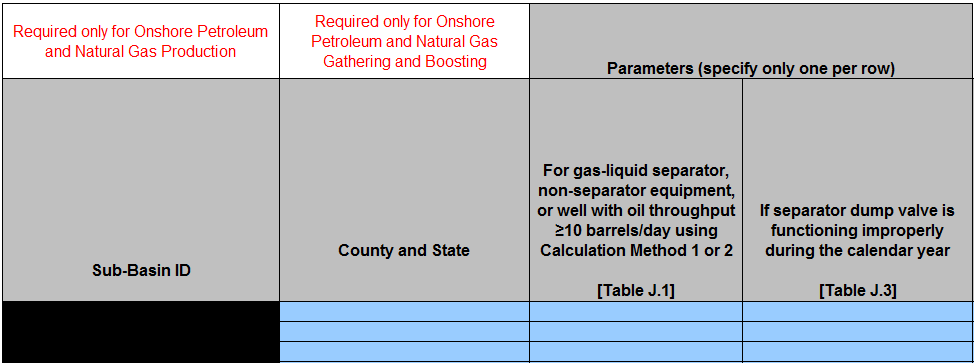This page provides an overview of the atmospheric storage tanks source type reporting requirements for Subpart W.
Please see Reporting Form Instructions on downloading the blank reporting form and uploading the completed reporting form.
You may also refer to Optional Calculation Spreadsheet Instructions to download the Subpart W calculation spreadsheet.
The atmospheric storage tanks source type is applicable to: Onshore petroleum and natural gas production [98.230(a)(2)] and Onshore petroleum and natural gas gathering and boosting [98.230(a)(9)].
For gas-liquid separators, onshore petroleum and natural gas gathering and boosting non-separator equipment, or wells with throughput ≥10 barrels/day to atmospheric storage tanks for which emissions are calculated using Calculation Method 1 or 2, Table J.1 must be completed. Note that Onshore petroleum and natural gas production facilities should report collective emissions calculated per sub-basin, and Onshore petroleum and natural gas gathering and boosting facilities should report collective emissions calculated per county and state. Reporters are not restricted to using only one Calculation Method per sub-basin or county and state. Thus, if atmospheric tank emissions for some throughput in a sub-basin (or county and state) are calculated using Calculation Method 1, and emissions for other throughput in the same sub-basin (or county and state) are calculated using Calculation Method 2, then the reporter should enter data for Calculation Method 1 on one row and enter data for Calculation Method 2 on a second row.
For gas-liquid separators, non-separator equipment, or wells with flow <10 barrels/day to atmospheric storage tanks for which emissions are calculated using Calculation Method 3, Table J.2.i must be completed; additionally, Table J.2.ii must be completed for non-flared emissions, and Table J.2.iii must be completed for flared emissions.
If Calculation Method 1 or 2 was used and separator dump valves were functioning improperly during the calendar year, Table J.3 must be completed.
Table J.4 is required for the identification of missing data procedures used for atmospheric storage tank emission calculations.
Table J.5 is required for reporting data associated with wildcat and delineation well delay claims made in 2015.
Indicate if the facility has the source type via the radio buttons.
If the source type is present you must report required elements.
Indicate which calculation methods were used and whether there were any malfunctioning dump valves via radio buttons.
If the facility has the source type, then indicate whether missing data procedures were used.
Reporting Requirements
Table J.1 Gas-liquid separator, non-separator equipment, or well with oil throughput ≥10 barrels/day using Calculation Method 1 or 2 required data elements include:
- Sub-Basin ID (required for Onshore petroleum and natural gas production facilities only) (98.236(j)(1)(i)) - the pick list for this data element is populated based on the (aa)(1) Onshore Production Tab. Be sure a valid Sub-basin ID is used.
- County and State (required for Onshore petroleum and natural gas gathering and boosting facilities only) (98.236(j)(1)(i))
- Calculation method used (98.236(j)(1)(ii))
- If you used Calculation Method 1, report the name of the software package used (98.236(j)(1)(ii))
- Total volume of oil sent to tanks from all gas-liquid separators and direct from wells or non-separate equipment (barrels per year) (98.236(j)(1)(iii))
- Onshore petroleum and natural gas production facilities must indicate whether or not the only wells used to calculate "total volume of oil" in the sub-basin were wildcat or delineation wells subject to a 2-year delay in reporting
- Note that the term “oil” in this data element is intended to mean all hydrocarbon liquids (i.e., oil plus condensate).
- Average gas-liquid separator or non-separator equipment temperature (oF) (98.236(j)(1)(iv))
- Average gas-liquid separator or non-separator equipment pressure (psig) (98.236(j)(1)(v))
- Average sales oil or stabilized oil API gravity (degrees) (98.236(j)(1)(vi))
- Minimum and maximum concentrations of CO2 and CH4 in flash gas (mole fractions) (98.236(j)(1)(vii, viii))
- Number of wells sending oil to gas-liquid separators or directly to atmospheric tanks (required for Onshore petroleum and natural gas production facilities only) (98.236(j)(1)(ix))
- Count of atmospheric tanks (98.236(j)(1)(x))
- Estimated number of atmospheric tanks not on well pads (required for Onshore petroleum and natural gas production facilities only) (98.236(j)(1)(xi))
- Were any emissions from atmospheric tanks controlled with vapor recovery systems? (98.236(j)(1)(xii)) If "Yes", the following information is required:
- Count of tanks that control emissions with vapor recovery systems (98.236(j)(1)(xii)(A))
- Total CO2 mass that was recovered (mt CO2) (98.236(j)(1)(xii)(B))
- Total CH4 mass that was recovered (mt CH4) (98.236(j)(1)(xii)(C))
- Annual CO2 emissions from tanks with vapor recovery systems (mt CO2) (98.236(j)(1)(xii)(D))
- Annual CH4 emissions from tanks with vapor recovery systems (mt CH4) (98.236(j)(1)(xii)(E))
- Were any emissions from atmospheric tanks vented directly to the atmosphere? (98.236(j)(1)(xiii)(A)) If "Yes", the following information is required:
- Count of tanks that vented directly to the atmosphere (98.236(j)(1)(xiii)(A))
- Annual CO2 emissions from venting (mt CO2) (98.236(j)(1)(xiii)(B))
- Annual CH4 emissions from venting (mt CH4) (98.236(j)(1)(xiii)(C))
- Were any emissions from atmospheric tanks vented to flares? (98.236(j)(1)(xiv)) If "Yes", the following information is required:
- Count of tanks with flaring emission control measures (98.236(j)(1)(xiv)(A))
- Annual CO2 emissions from flaring (mt CO2) (98.236(j)(1)(xiv)(B))
- Annual CH4 emissions from flaring (mt CH4) (98.236(j)(1)(xiv)(C))
- Annual N2O emissions from flaring (mt N2O) (98.236(j)(1)(xiv)(D))
Table J.1 Gas-liquid separator, non-separator equipment, or well with oil throughput ≥10 barrels/day using Calculation Method 1 or 2 (only one row of the table is shown below)
Enlarged View of Table J.1 Gas-liquid separator, non-separator equipment, or well with oil throughput ≥10 barrels/day using Calculation Method 1 or 2
Enlarged View of Table J.1 Gas-liquid separator, non-separator equipment, or well with oil throughput ≥10 barrels/day using Calculation Method 1 or 2 (continued)
Enlarged View of Table J.1 Gas-liquid separator, non-separator equipment, or well with oil throughput ≥10 barrels/day using Calculation Method 1 or 2 (continued)
Enlarged View of Table J.1 Gas-liquid separator, non-separator equipment, or well with oil throughput ≥10 barrels/day using Calculation Method 1 or 2 (continued)
Enlarged View of Table J.1 Gas-liquid separator, non-separator equipment, or well with oil throughput ≥10 barrels/day using Calculation Method 1 or 2 (continued)
Enlarged View of Table J.1 Gas-liquid separator, non-separator equipment, or well with oil throughput ≥10 barrels/day using Calculation Method 1 or 2 (continued)
Table J.2.i Wells, separators, and non-separator equipment with oil throughput <10 barrels/day using Calculation Method 3 required data elements are described below. Note that the oil/condensate throughput and counts of tanks and wells reported in this table should only include those assessed using Calculation Method 3.
- Estimate of fraction of oil/condensate throughput sent to tanks in basin with flaring (98.236(j)(2)(i)(B))
- Estimate of fraction of oil/condensate throughput sent to tanks with vapor recovery system control measures (98.236(j)(2)(i)(C))
- Count of atmospheric tanks in basin (98.236(j)(2)(i)(D))
- Onshore petroleum and natural gas production facilities must also report:
- Count of wells with gas-liquid separators (98.236(j)(2)(i)(E))
- Count of wells without gas-liquid separators (98.236(j)(2)(i)(F))
- Total annual oil/condensate throughput that is sent to all atmospheric tanks (barrels per year) (98.236(j)(2)(i)(A))
- Onshore petroleum and natural gas production facilities must indicate whether or not the only wells used to calculate "total annual oil/condensate throughput that is sent to all atmospheric tanks" in the sub-basin were wildcat or delineation wells subject to a 2-year delay in reporting
Table J.2.i Wells, separators, and non-separator equipment with oil throughput <10 barrels/day using Calculation Method 3
Table J.2.ii Data for wells, separators, and non-separator equipment with oil throughput <10 barrels/day, without flaring, using Calculation Method 3 requirements include:
- Sub-Basin ID (required for Onshore petroleum and natural gas production facilities only) (98.236(j)(2)(ii)(A)) - the pick list for this data element is populated based on the (aa)(1) Onshore Production Tab. Be sure a valid Sub-basin ID is used.
- County and State (required for Onshore petroleum and natural gas gathering and boosting facilities only) (98.236(j)(2)(ii)(A))
- Count of tanks that did not control emissions with flares (98.236(j)(2)(ii)(B))
- Annual CO2 emissions from tanks without flares (mt CO2) (98.236(j)(2)(ii)(C))
- Annual CH4 emissions from tanks without flares (mt CH4) (98.236(j)(2)(ii)(D))
Table J.2.ii Data for wells, separators, and non-separator equipment with oil throughput <10 barrels/day, without flaring, using Calculation Method 3
Table J.2.iii Data for wells, separators, and non-separator equipment with oil throughput <10 barrels/day, with flaring, using Calculation Method 3 requirements are described below. Note that when emissions from atmospheric storage tanks are routed to flares, section 98.233(j)(5)(i) requires reporters to use the ‘volume and gas composition in this section.’ For Calculation Method 3, this means the volume of flared gas should be the sum of the volume of CO2 plus the volume of CH4 calculated using Equation W-15. This sum should be used for the term Vs in Equations W-19 and W-20. Additionally, you should assume that CO2 and CH4 are the only compounds in the flared gas.
- Sub-Basin ID (required for Onshore petroleum and natural gas production facilities only) (98.236(j)(2)(iii)(A)) - the pick list for this data element is populated based on the (aa)(1) Onshore Production Tab. Be sure a valid Sub-basin ID is used.
- County and State (required for Onshore petroleum and natural gas gathering and boosting facilities only) (98.236(j)(2)(iii)(A))
- Count of tanks with flaring emission control measures (98.236(j)(2)(iii)(B))
- Annual CO2 emissions from tanks from flaring (mt CO2) (98.236(j)(2)(iii)(C))
- Annual CH4 emissions from tanks from flaring (mt CH4) (98.236(j)(2)(iii)(D))
- Annual N2O emissions from tanks from flaring (mt N2O) (98.236(j)(2)(iii)(E))
Table J.2.iii Data for wells, separators, and non-separator equipment with oil throughput <10 barrels/day, with flaring, using Calculation Method 3
Table J.3 Emissions from improperly functioning dump valves must be completed if Calculation Method 1 or 2 were used, and any gas-liquid separator liquid dump valves did not close properly during the calendar year. Data requirements include:
- Sub-Basin ID (required for Onshore petroleum and natural gas production facilities only) (98.236(j)(3)) - the pick list for this data element is populated based on the (aa)(1) Onshore Production Tab. Be sure a valid Sub-basin ID is used.
- County and State (required for Onshore petroleum and natural gas gathering and boosting facilities only) (98.236(j)(3))
- Count of gas-liquid separators whose liquid dump valves did not close properly (98.236(j)(3)(i))
- Total time the dump valves did not close properly (98.236(j)(3)(ii))
- CO2 emissions from improperly functioning dump valves (mt CO2) (98.236(j)(3)(iii))
- CH4 emissions from improperly functioning dump valves (mt CH4) (98.236(j)(3)(iv))
Table J.3 Emissions from improperly functioning dump valves
Table J.4 Missing data procedures used for Atmospheric Storage Tank emission calculations is required if your facility relied on missing data procedures to develop data elements used in calculating atmospheric storage tank emissions:
- Sub-Basin ID (required for Onshore petroleum and natural gas production facilities only) - the pick list for this data element is populated based on the (aa)(1) Onshore Production Tab. Be sure a valid Sub-basin ID is used.
- County and State (required for Onshore petroleum and natural gas gathering and boosting facilities only)
Parameters associated with Table J.1
Parameters associated with Table J.3
- Measurement Frequency
Number of quarters missing data procedures were used [98.236(bb)(1)] (required only if the measurement frequency was quarterly)
Total number of hours in the year missing data procedure was used [98.3(c)(8)], [98.236(bb)(2)] (required unless the measurement frequency was quarterly, annually, biannually, or N/A)
Procedures used for missing data [98.235(h)]
Table J.4 Missing data procedures used for Atmospheric Storage Tank emission calculations
Enlarged View of Table J.4 Missing data procedures used for Atmospheric Storage Tank emission calculations
Enlarged View of Table J.4 Missing data procedures used for Atmospheric Storage Tank emission calculations (continued)
Table J.5 Delayed RY2015 Data (for delays claimed in RY2015) is required if you delayed reporting in RY2015 for gas-liquid separator or well with oil throughput ≥10 barrels/day using RY2015 Calculation Method 1 or 2, or if you delayed reporting total annual oil throughput when using Calculation Method 3.
- Sub-basin ID (required for Calculation Methods 1 and 2)
- Total annual volume of oil sent to tanks from gas-liquid separators and direct from wells (Calculation Methods 1 or 2) (barrels per year) [98.236(j)(1)(iii)]
- Total annual oil throughput that is sent to all atmospheric tanks in the basin (Calculation Method 3) (barrels per year) (98.236(j)(2)(i)(A)]
- Well ID Number(s) [98.236(j)(1)(iii) and (2)(i)(A)]
Table J.5 Delayed RY2015 Data (for delays claimed in RY2015)
Total Emissions
The total emissions roll-up at the top of the sheet reflects the sum of each gas emission reported for the source type. These summations are calculated automatically by the Smart Form and tabulated on the Introduction tab.



